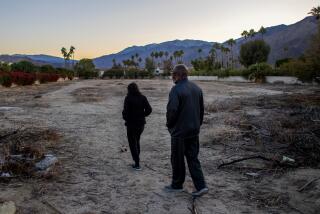An Appreciation: Architect Donald Wexler made Palm Springs modern
By the time Richard Neutra, R.M. Schindler and other modernist architects began making a noticeable mark on Los Angeles in the decades before World War II, a good number of the city’s major public buildings were already in place.
A certain strain of handsome revivalism had solidly established itself: There was an expectation that new civic and commercial buildings would be wrapped in Spanish or Mediterranean dress, with occasional forays into Art Deco or Streamlined Moderne.
There would be no flat-roofed City Hall for Los Angeles, no big train station in the International Style.
Out in the desert a few years later, it was a different story. Palm Springs and California modernism came of age together right after the war. Its leading architects had a chance not just to build modern houses for new subdivisions but to give Palm Springs a public face, a civic personality.
Donald Wexler, who died last week in Palm Desert at age 89, produced no shortage of residential work over his remarkably long career, including a house for Dinah Shore and a group of seven experimental steel-framed houses on the north side of Palm Springs that young architects still go out of their way to see.
But when he arrived in the desert in the fall of 1952, after studying at the University of Minnesota on the GI Bill and a brief stint in Neutra’s Los Angeles office, Wexler realized that Palm Springs was busy planning a range of public institutions — and that those institutions needed architects.
“It was a very small community when I came here, maybe 7,000 people,” he told one interviewer. “It closed down for four months in the summer — there was nothing here. There were no doctors, no dentists. The first year there was one restaurant open. In the middle of July, the safest place in the world to go to sleep would have been in the middle of Palm Canyon Drive at high noon.”
Working first for the established Palm Springs architect William F. Cody, then in partnership with Richard Harrison and finally, by 1962, on his own, Wexler sealed the link between progressive architecture and the city’s self-image.
Cody, John Lautner and E. Stewart Williams, along with the Swiss émigré Albert Frey and his collaborators John Porter Clark and Robson Chambers, produced forward-looking public and private work in the desert in the postwar years.
But it was Wexler, as much as any architect, who made Palm Springs modern.
His many public projects include the Palm Springs International Airport main terminal (1966), Palm Desert Middle School (1978) and High School (1990), a building for the Desert Water Agency (1978), the Palm Springs Police Department (1985) and the Indio Hall of Justice (1994). Wexler also designed experimental steel classrooms for Palm Springs High School in the late 1950s and, a few years later, a minimal football stadium for the school with bleachers set into a landscaped berm.
Together with Wexler’s banks, medical facilities and country-club buildings, these civic commissions, especially the airport, made the architect’s reputation even as they made that of Palm Springs.
Because he was so prolific and started so young — he was 26 when he and Harrison quit Cody’s firm to found their own — Wexler also leaves behind a body of work that suggests the evolution, the many chapters, of postwar modernism in California.
Elegant if straightforward post-and-beam projects like Wexler’s own Palm Springs house from 1955, framed in wood and close in spirit to certain Case Study houses in Los Angeles, led to experiments in steel-framed prefabrication and jet-set designs in the 1960s.
And if Wexler never strayed into ornamental and historically minded post-modernism in the 1970s and 1980s, the way a few of his generation did, his architecture in those decades turned more sculptural. As the bermed football stadium suggested, Wexler’s work also showed an increasing interest in environmental efficiency, in solar energy in particular.
There was an optimism inherent in nearly all of his work, in its clear, light-on-its-feet structural logic and material palette.
Steel was cheap and abundant enough in the 1950s to use in classrooms and small houses as well as major civic buildings. The seven steel houses Wexler and Harrison designed in the Racquet Estates neighborhood, prototypes underwritten by U.S. Steel, averaged less than 1,500 square feet.
With the long spans made possible by steel construction, architects no longer had to rely on heavy or opaque load-bearing material. Steel enabled lots of glass, which enabled a dramatic transparency in Wexler’s work, whether the buildings looked out on the desert landscape or the backyard pool.
In Palm Springs there was also less of the hand-wringing and consternation that sometimes greeted efforts to design public buildings in Los Angeles in the modernist style.
Wexler’s airport design was built largely as he’d envisioned it, with windows nearly 30 feet high framing views of the mountains. An ambitious plan around the same time for LAX by Charles Luckman and William Pereira, and later Pereira alone, was modified, scaled back and value-engineered within an inch of its life.
Just as important as Wexler’s early start in the desert was the fact that he never left. After selling his office to the large firm WWCOT in 2000, he retired in 2002.
That’s an even 50 years working in Palm Springs, helping shape a fast-growing city whose ambition and taste in architecture neatly matched his own.
christopher.hawthorne@latimes.com
More to Read
The biggest entertainment stories
Get our big stories about Hollywood, film, television, music, arts, culture and more right in your inbox as soon as they publish.
You may occasionally receive promotional content from the Los Angeles Times.







